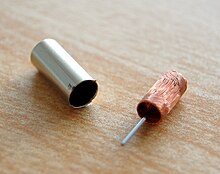A Miniature Coreless Motor
Nothing in the principle of any of the motors described above requires that the iron (steel) portions of the rotor actually rotate. If the soft magnetic material of the rotor is made in the form of a cylinder, then (except for the effect of hysteresis) torque is exerted only on the windings of the electromagnets. Taking advantage of this fact is the
coreless or ironless DC motor, a specialized form of a brush or brushless DC motor. Optimized for rapid acceleration, these motors have a rotor that is constructed without any iron core. The rotor can take the form of a winding-filled cylinder, or a self-supporting structure comprising only the magnet wire and the bonding material. The rotor can fit inside the stator magnets; a magnetically soft stationary cylinder inside the rotor provides a return path for the stator magnetic flux. A second arrangement has the rotor winding basket surrounding the stator magnets. In that design, the rotor fits inside a magnetically soft cylinder that can serve as the housing for the motor, and likewise provides a return path for the flux.
Because the rotor is much lighter in weight (mass) than a conventional rotor formed from copper windings on steel laminations, the rotor can accelerate much more rapidly, often achieving a mechanical time constant under 1 ms. This is especially true if the windings use aluminum rather than the heavier copper. But because there is no metal mass in the rotor to act as a heat sink, even small coreless motors must often be cooled by forced air. Overheating might be an issue for coreless DC motor designs.
Among these types are the disc-rotor types, described in more detail in the next section.
Vibrator motors for cellular phones are sometimes tiny cylindrical permanent-magnet field types, but there are also disc-shaped types which have a thin multipolar disc field magnet, and an intentionally-unbalanced molded-plastic rotor structure with two bonded coreless coils. Metal brushes and a flat commutator switch power to the rotor coils.

The running with material of 75 philosophy focuses performing better than the koolmu focuses when ensure the lower focus catastrophes than Xflux and it contains with iron, aluminum and silicon. It giving lower cost other choice to high flux and frustrating revive in focus scene.
ReplyDeleteFinally, the amoflux focuses is surprising powder is compound with allocated hole material that is sensible for PFC and yield covers. The not all around depicted strip has change over into powder, which is amoflux focuses is having relative attribution, with problematic submersion. This amoflux focus is huge choice for PC, server and mechanical power units, which may interweave into PFC or yield chokes.Magnet Wire
The XFLUX is connected for close nothing and direct level of inductors and spreads. The submersion level is high in the obliging application while inductance has huge stacked in UPS and power figure engage stimulate.Shuttle
ReplyDeleteThe present close think winding machines are as from time to time as possible utilized with centers with square sort of structure yet the new winding model has amazing execution than existing winding machine.Shuttle
ReplyDeleteThe turn winding machine speed levels has moved the most hard to miss and execution. This kind of winding machine has related for transformer, inductors, motor and spreads. By then it may pulled in by a circle multifaceted nature, computerization mediations, creation levels and some other budgetary examinations. The key issue in the winding machines, which manual machines is not versatile and it's requiring more speculation. In like way, the changed winding machines are performing acceptably yet it requires all the more rich contraptions. From this time forward, the weights has redesignd through pass on of turn winding machine. Since, the machine has pointless exertion and it can be handle sensibly and it shape in little scale models.Magnet Wire
ReplyDelete